Puede leer este artículo en español aquí.
The two Guatemalan boys huddled under a shiny black blanket that reflected the moonlight. It was their first night alone. Their only link to family was a cellphone, so they texted their uncle, Carlos D.L., in California: “Tío conteste, nos dejaron tirados.” Uncle, they left us here.
Nine nights earlier, around 3 a.m., the boys had crossed the U.S.-Mexico border in Sonoyta with around 15 others and a smuggler. They trekked across the Sonoran Desert, up and down rugged hills and across dry washes, with garlic rubbed on their shoes to repel snakes. J.G., who was 18 at the time, and his 20-year-old cousin, K.G., carried 50-pound backpacks with jerky, Maruchan cup noodles, energy drinks and the Paris Saint-Germain soccer jerseys they’d purchased in Mexico. The four one-gallon bottles of water tied to J.G.’s bag slammed against his body with every step.
The group rested in the shade of saguaros and mesquites for short stretches, hiding from the U.S. Border Patrol’s surveillance drones. Their dull-colored, dusty clothes offered camouflage, but they couldn’t have hidden from the drones’ infrared cameras. It was October, and temperatures rose above 90 degrees Fahrenheit during the day and dropped to the low 50s at night. They walked endlessly, resting for as little as an hour at a time, to their destination: a spot near a road where the smuggler’s contact could pick them up. The smuggler gave them stimulant pills to keep going.
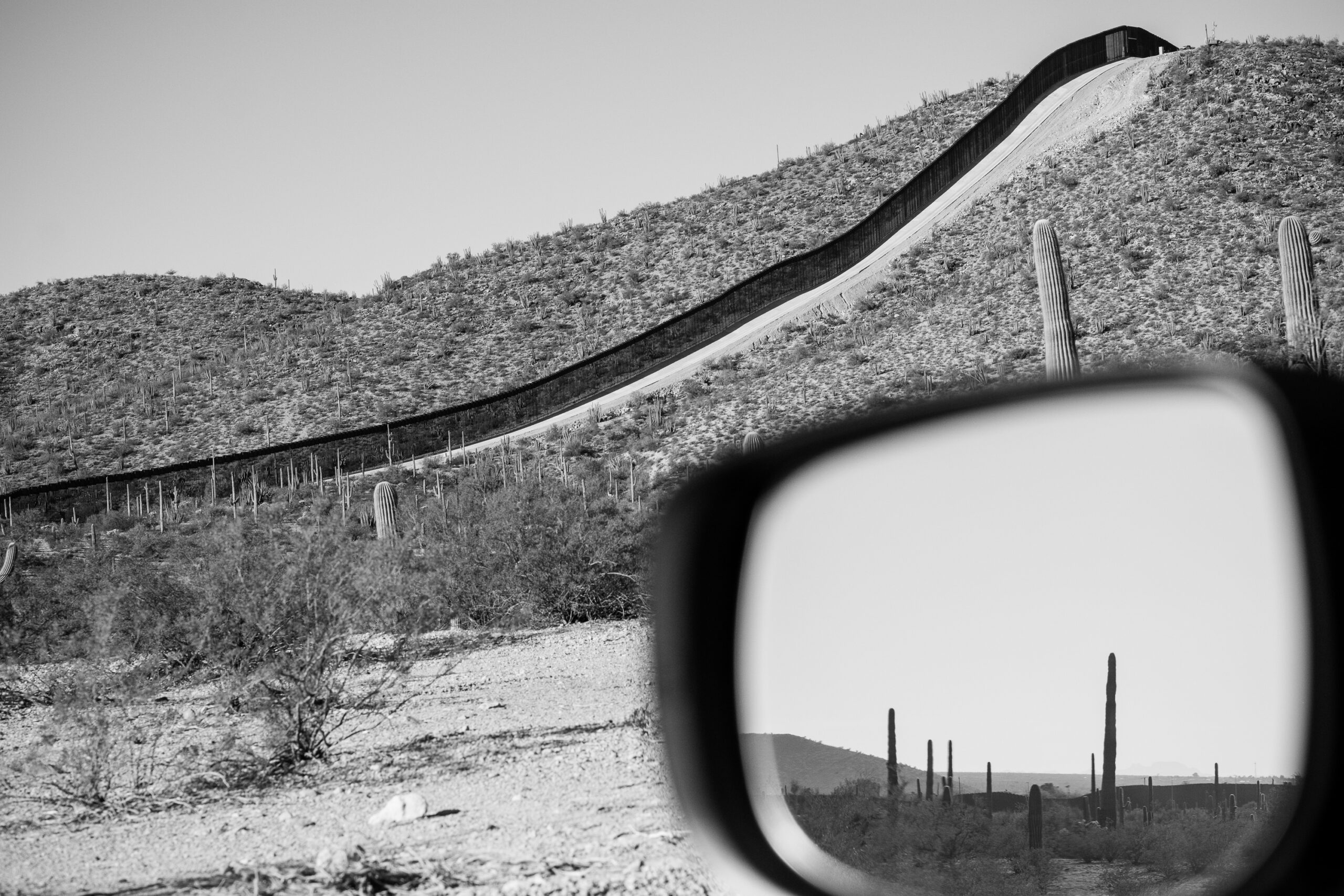
View of the border wall near the Sonoyta border crossing. Image: Roberto (Bear) Guerra/HCN
By day six, their feet were scratched, raw and bloody with blisters. On day seven, they ran out of water. Some were so thirsty they drank their own urine. That day, as they climbed a mountain, they heard what sounded like animal howls. They scrambled to get away, but the rocks under J.G.’s feet gave way, and he slipped. His hand hit a cactus, and his ankle twisted. He tried to push through the pain, but by the next day, the pills were gone and his body was failing. On the ninth day, J.G. started vomiting. Without sleep and water, he soon collapsed.
The smuggler told the boys to rest. He pointed to a mountain in the distance: That’s the pick-up point, he said, and moved on with the others. The image of the mountain became etched in J.G.’s delirious mind. Eventually, the cousins got up, moving slowly, achingly, toward the hill. When they found tire tracks, they stopped, confused. Was this their destination? That couldn’t be right; the guide had said it would take another two days. But they set up camp for the night anyway, hoping that whoever left the tracks would soon return.
Now, whenever drones buzzed overhead, they tried to flag them down. As the cold night set in, they kindled a fire they hoped would be visible from afar. They were no longer trying to hide.

A hat and child’s blanket left on the ground on the U.S. side of the border wall near Sonoyta, Mexico. Image: Roberto (Bear) Guerra/HCN
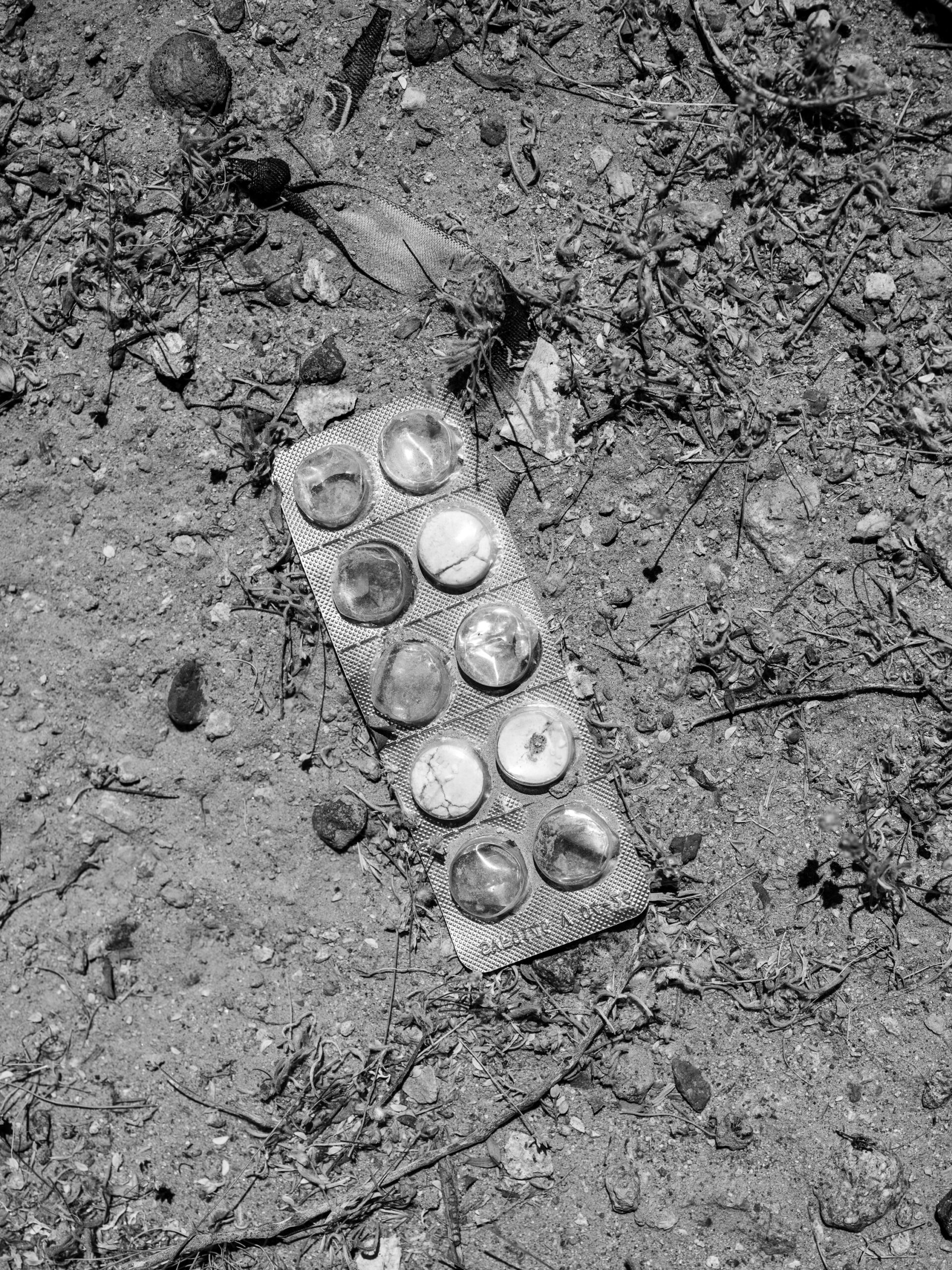
Medication left behind at a CBP migrant holding camp near the Sonoyta border crossing. Image: Roberto (Bear) Guerra/HCN
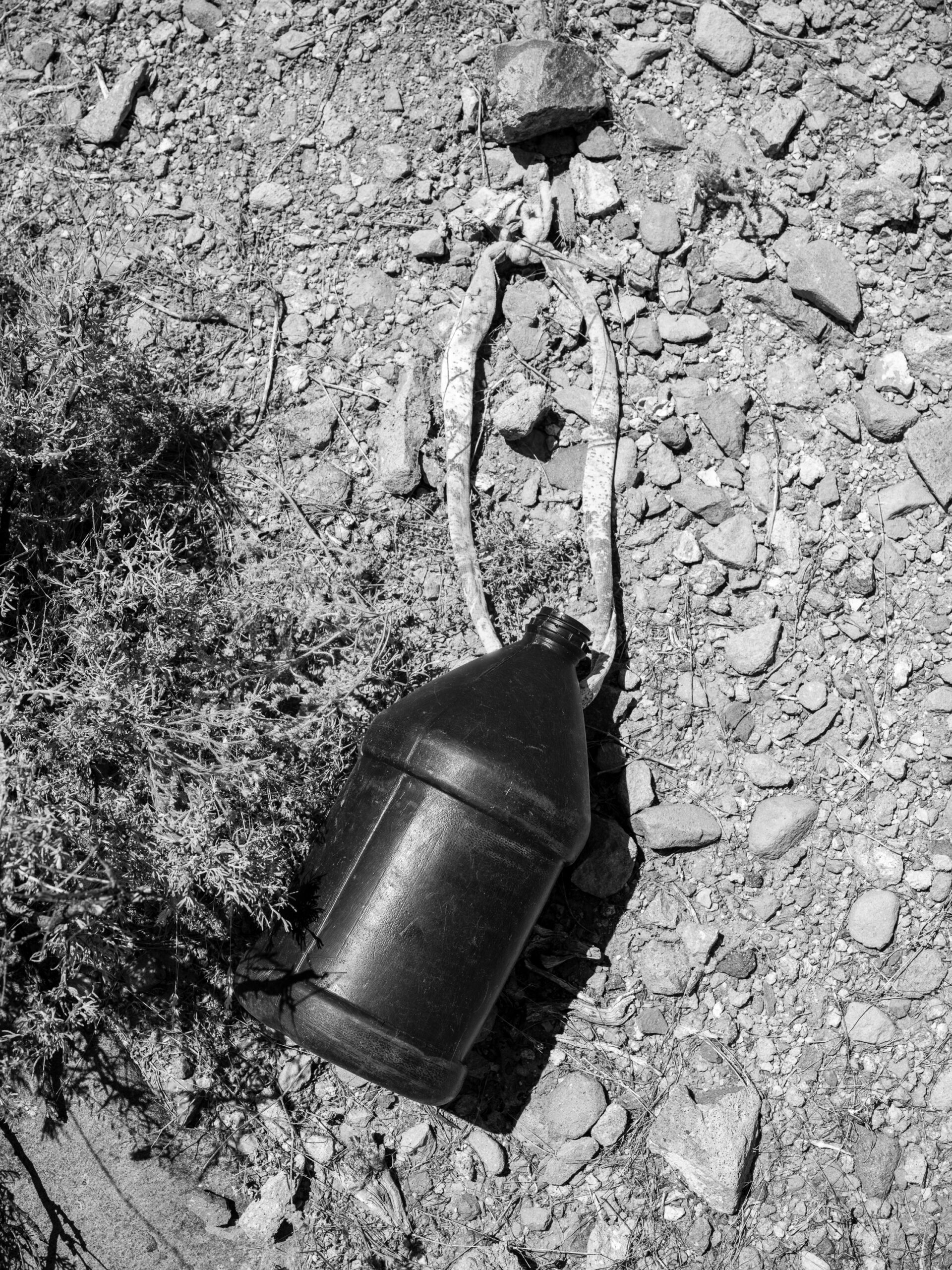
A black water jug with an improvised carrying strap was left behind in the desert near the Tohono O’odham Reservation in southern Arizona. Image: Roberto (Bear) Guerra/HCN

Migrants often wear carpet “shoes” to hide their footprints when crossing through the desert. Image: Roberto (Bear) Guerra/HCN
In the early hours of Oct. 18, the boys called their uncle. They later texted a screenshot of their location on Google Maps. It was 8:47 a.m., and their phone battery was at 5%. Carlos urged them to call 911. By the time they did, the battery was at 3%.
The U.S.-Mexico border is the world’s deadliest land route for migrants, according to the International Organization for Migration. Thousands who try to cross it get lost, injured or sick and have to call 911 for help. For over a decade, local authorities in U.S. border towns have redirected calls from lost Spanish-speaking callers to the Border Patrol, the subagency of the U.S. Customs and Border Protection (CBP) that pursues and arrests border crossers. The agency’s Missing Migrant Program is the federal government’s primary response to the migrant death toll, which has been trending upward for 20 years. Between 2014 and 2023, nearly 60% of the migrant deaths in the Americas occurred in the U.S.-Mexico border region — far surpassing the toll in the waters of the Caribbean and the jungles of the Darien Gap.
The Missing Migrant Program aims to minimize the death toll through, among other things, putting up placards advising migrants to call 911, facilitating rescue attempts and, when necessary, recovering remains. The Border Patrol has touted its progress, and in 2023, Congress expanded the program’s funding with bipartisan support. Money was earmarked for “rescue beacons” — towers fitted with reflectors, blue lights, buckeye motion-sensing cameras and a button for migrants to press to call for help. The agency requested around the same amount for fiscal year 2025, saying the money was needed for more beacons as well as for “training, personal protective equipment, travel and supplies.”
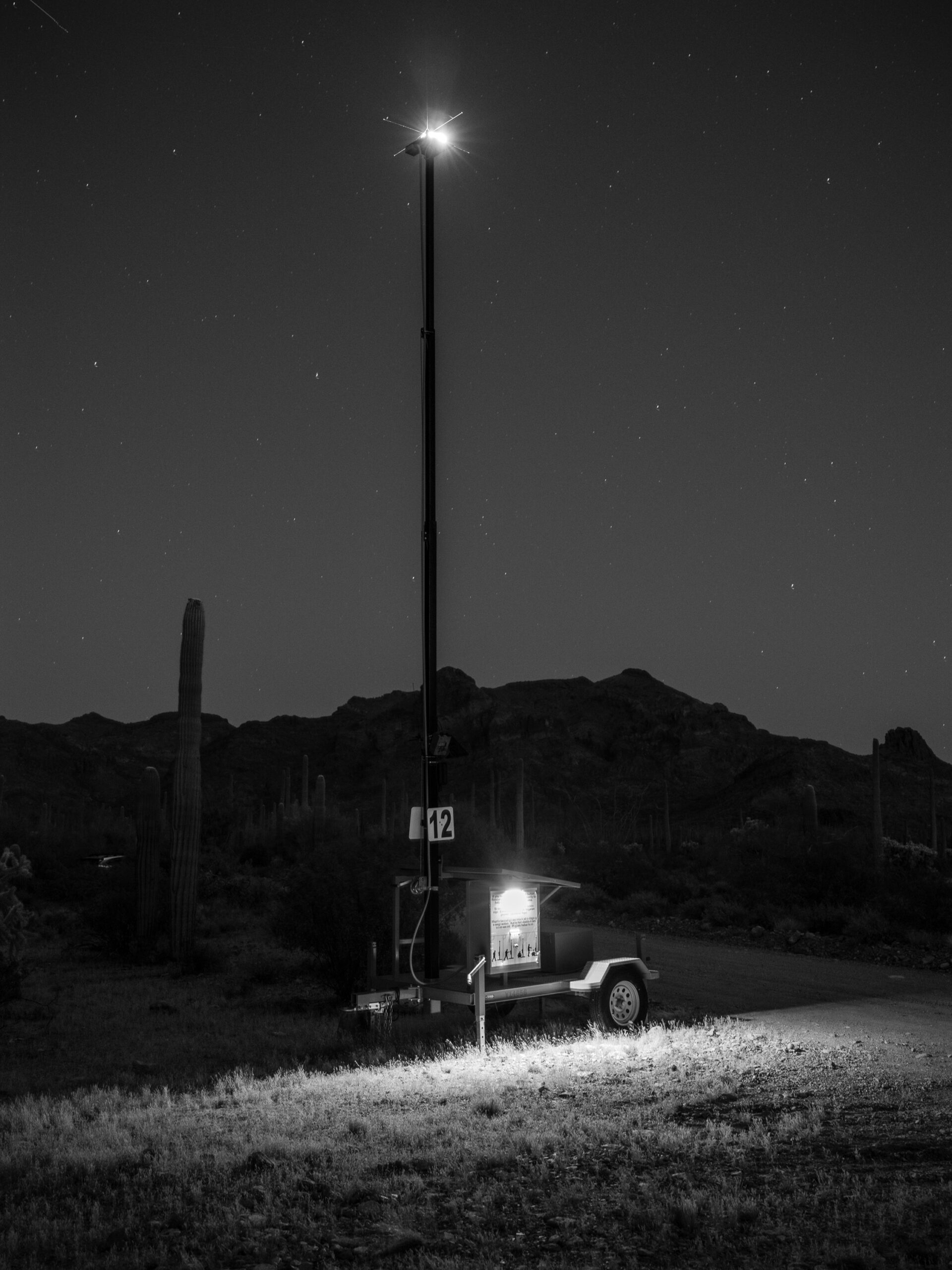
A Missing Migrant Program rescue beacon in Organ Pipe Cactus National Monument near the U.S.-Mexico border in Arizona. Image: Roberto (Bear) Guerra/HCN
Many local officials and residents believe that the Border Patrol should bear primary responsibility for migrant rescues and recoveries. The agency is part of CBP, which is itself part of the Department of Homeland Security, and its resources dwarf those of local emergency teams and nonprofits. But some aid workers and border researchers see a conflict of interest between the agency’s primary mandate, which is to detain and deport migrants, and the humanitarian goal of saving lives. Both outside critics and Border Patrol agents acknowledge that the two goals are intertwined, but only the former see this as a problem.
Type Investigations and High Country News looked into the complicated relationship between the Border Patrol’s law enforcement and rescue operations, using internal documents, data logs, congressional reports, migrant accounts and the testimony of agents. These records reveal how the agency’s dogged pursuit of migrants can increase the danger for those same migrants, occasionally ending in tragedy. Migrants drown or fall off cliffs; they die in car crashes and from the direct use of force by Border Patrol agents. While the agency does appear to pick up thousands of migrant callers alive, those rescues often end in arrest and deportation. So far, there has been little public accountability for the program’s failures, while the data shows that hundreds of migrants who reach out for help fall through the cracks and are never seen again.
J.G. and his cousin told the 911 operator that they wanted to talk to someone who spoke Spanish. They were eventually transferred to a Border Patrol agent at the Arizona Air Coordination Center, or A2C2, a control room in the agency’s Tucson Sector headquarters and the heart of its Missing Migrant Program. Considered a model for Border Patrol sectors across the Southwest, this high-tech arena costs millions. Dizzying digital maps of southern Arizona are splashed across three walls. On the large one in the center, tiny blinking white dots represent all the border agents in the field. Blue dots indicate air and marine aircraft, and mobile surveillance trucks appear as tiny rectangles. Underneath all these data points swell the Baboquivari Mountains, sacred to the Tohono O’odham people, whose land north of the border spans Pima, Maricopa and Pinal counties.
911 calls redirected from the southern Arizona region are swiftly geolocated on the large digital map, which agents call the “big pipe.” Emergency calls are marked as little red phone receivers. The agent on duty sits at a desk facing the maps, fortressed by as many as four computer monitors, and logs the intake. Each call is categorized based on how bad the caller’s condition appears to the agent: “routine enforcement,” the lowest priority; “uncertain”; “alert” and “distress.”
The boys were questioned — how many people were there, was anyone injured or sick — J.G. said, and then the line went silent. Eventually, the agent told them to wait: Someone would come for them in half an hour. Just 10 minutes later, the boys saw a car in the distance, a green-and-white vehicle with a logo they recognized in the warming daylight as that of Border Patrol. The driver’s window was down. They dropped everything and ran after the car, waving, but it didn’t stop. Frustrated, they threw stones at it. One hit it, but the car drove on.
Carlos had lost contact with his nephews after they texted him that morning. He called his immigration lawyer and was connected to the Guatemalan Consulate and Mario Agundez, an Arizona Border Patrol agent who was central to the agency’s rescue operations. Having these direct lines of communication left Carlos in much better shape than most migrant families with missing or injured loved ones.
During his 20-plus years as a Border Patrol agent, Agundez, who retired at the end of 2023, had often received frantic calls from the families of missing migrants. Privacy and security issues generally prevent agents from providing direct information on rescue operations to civilians, agents say, so they advise families to talk to their consulates. But Carlos and his wife were not getting much clarity from the consulate. “It was a mess, so I told the family, ‘Just stay with me, let me help you put this thing together,’” Agundez said. He passed on the location information he received from the family and checked with his colleagues for updates.
Migrant deaths hit close to home for Agundez, even before he became an agent. In 1998, his then-wife’s cousin died crossing the border. Agundez, who left Mexico at 17, joined the U.S. Border Patrol’s newly formed search, trauma and rescue team (BORSTAR) — a subset of agents with specialized emergency-response skills — two years later. Agundez, who feels his own immigrant background helps him understand why migrants risk their lives to cross, designed the Missing Migrant Program in 2017, making it the latest iteration of the rescue program that started in 1998. “Why are they taking that risk? A lot of people want the American dream,” he said. “I’m trying to strive for my American Dream,” he added, “by waking others from their worst nightmare” through his rescue initiative.
It started in 2004 in southern Arizona, when his boss handed him a cellphone and told him he’d be taking 911 calls from surrounding counties, a job that earned him the nickname “Mr. 911’’ in the local news. In 2015, Agundez shifted the responsibility of working the phones to a small team of border officials and began designing the training curriculum and protocols for the Missing Migrant Program. It wasn’t easy getting other agents on board. Many of his colleagues, he said, “were like, ‘Well, if you’re not dying, why are you calling 911? Just another quitter — overcrowding the 911 service.’”
Through the Missing Migrant Program, Agundez sought to centralize the rescue operations and improve the flow of information down the chain of command. He persuaded reluctant colleagues by pointing out that a systematic rescue program could yield law enforcement benefits: Rescued migrants could provide firsthand information on smugglers, for example, which could be used to capture and prosecute the cartels behind the operation. The “quicker we can respond and address that border safety issue by saving lives, the quicker we can get back to border security,” Agundez said.
Law enforcement goals have been embedded in the CBP rescue system from the beginning. Today, the program does not exist as an independent department with permanent, dedicated staff, but rather as a system manned by a rotating set of agents that distills information from 911 calls, family members, consulates and volunteer groups and gets it out to the local stations. The main challenge — apart from the rugged terrain, unpredictable weather and spotty phone signal — is that the smugglers are deliberately making use of trails in desolate, mountainous areas in order “to avoid detection and interception,” according to an agency fact sheet. That’s where the high-tech maps and surveillance tools at A2C2 come in handy. “All these resources? Their main job is border security,” said John Mennell, an agency spokesperson. “But 4,000-plus agents — our air and marine and other assets can turn on a dime to pull someone off the Baboquivari Mountain.”
When a call comes in, agents first check the CBP arrest and detention databases in case the missing migrant is already in custody. When migrants themselves call, they’re often afraid to give their real names and descriptions out of fear of the Border Patrol. “We’re known as the boogeyman,” agent Daniel Hernandez said. “We have this lore that follows us, for better or for worse.”
If the database doesn’t yield a hit, the agents detailed to the A2C2 code the request’s urgency and forward the details to the local CBP station. If station officials dispatch someone, it is usually an agent already in the field. Specially trained BORSTAR agents, who in agency press videos are often seen treating migrants with IVs in the field or dropping from helicopters to rescue people, are called in a small subset of cases, according to internal CBP records from 2021.
“We’re known as the boogeyman. We have this lore that follows us, for better or worse.”
A database of A2C2 911 calls from October 2021 to September 2022, obtained through a public records request, provides a never-before-seen window into how the agency handles distress calls in its Tucson sector. Out of around 3,000 calls that came in that year, over 80% were initially categorized as “routine enforcement,” meaning that agents determined that the callers would not deteriorate or require lifesaving help within 24 hours. (Calls remain active on the map for 24 hours.) A similar proportion — about 87% of cases were labeled as “give ups” owing to the eventual outcome; like “quitters,” it’s a term used for exhausted migrants who cannot keep going. These migrants are, according to Mennell, “looking for that 911-Uber ride” to the processing cell. But around 5% of calls were placed into the high-priority “distress” or “alert” categories by A2C2 agents, meaning the caller might have deteriorated rapidly or even died without help.
Agundez admits Border Patrol agents are not trained as medical dispatchers and so could be “downplaying the nature” of some of the calls. Still, he thinks these numbers show the program’s success. “The more ‘give ups’, the less true emergencies, less hospitalizations, shows that the 911 call system of communication works for us — works for the migrants,” he said. The fact that rescues and arrests coincide is not a bug, but a feature of the system to agents. “Yes, we do chase after our own patients,” Agundez said. “Hopefully, we get to them alive.”
Out of 3,000 emergency calls in 2022, 38 (1.2%) were categorized as medical emergencies and only six appeared to have triggered a search and rescue expedition. Another 299 Tucson-region callers who were rerouted to the A2C2 that year were never found; 180 of these were initially deemed “routine” or low-priority. In at least a third of these cases, the agency had somewhat precise coordinates for the caller.
To Parker Deighan, a longtime volunteer with No More Deaths, the fact that 300 missing migrants — almost twice the number of migrant deaths recorded in Arizona that year — were not found after calling 911 “really shows Border Patrol’s complete failure to treat these calls as true emergencies.” People who choose to cross have urgent reasons, Deighan said, and don’t “give up” unless they’re compelled to do so out of genuine fear for their lives. “It shows how the dehumanization inherent in enforcing the border really makes it impossible for Border Patrol to be effective rescuers,” she added.
The way these 911 calls are funneled to enforcement agents may also violate the international standards laid out in the U.N. Refugee Agency’s Emergency Handbook, which requires that humanitarian actors not be “subject to control, subordination, or influence by political, economic, military or other non-humanitarian objectives.” The Border Patrol’s law enforcement mandate targets the same group it purports to rescue, “so in the name of security, a lot of human rights get shoved aside,” said Ieva Jusionyte, an anthropologist at Brown University and a former emergency responder who researches emergency services and violence along the border. “One of those rights is to receive medical care … and the right to that care not being contingent on also being detained and arrested and deported.”

Migrants’ backpacks and other belongings scattered on the ground in the Sonoran Desert near the Tohono O’odham Nation in Arizona. Image: Roberto (Bear) Guerra/HCN
The rescue machinery affords substantial discretion to an agency that human rights groups have criticized as having a culture of contempt for migrants. A Huffington Post investigation recently found that agents used anti-immigrant slurs, including one, “tonk,” supposedly named after the sound a flashlight makes when slammed against someone’s head. Some even joked about killing migrant children. In the past, the agency has failed to hold people accountable when abuses come to light, according to a 2021 report released by the House Committee on Oversight and Reform.
All this, combined with the Border Patrol’s history and the way it has historically operated in the Southwest, should disqualify it from doing humanitarian searches, said attorney Angelo Guisado of the Center for Constitutional Rights, who represents No More Deaths in litigation seeking CBP’s internal records on its emergency operations. “If they think everything looks like a nail, they’re going to use a hammer, right?”
On Oct. 18, Carlos and his wife, Claudia L., drove to Arizona themselves, accompanied by three family friends. “I had the location, and I was not going to leave one of my family members dying out there in the desert,” Carlos said.
After they arrived, the consulate informed them that the boys had not been found at the location they’d sent. Claudia and the friends drove out to look for themselves, while Carlos stayed behind at the hotel to monitor updates.
Agundez said that the boys’ 911 call was not prioritized as urgent and that it lacked very precise coordinates. The agents checked the general area they’d called from twice in the following 18 hours but did not see them. Agundez thought the boys had just moved on from their original location.
“So that’s what agents do: They show up to the area and go look around a little bit here and there to see if there’s any signs, and they are like, ‘They’re gone,’” Agundez said. “There’s so many variables. Could agents have deployed the whole station? Does it sound operational — reasonable?” Agents have to make rescue decisions considering their “first and foremost priority” is border security, especially given limited resources, he added.
The Border Patrol saw its budget increase tenfold between 1993 and 2021, as the agency formalized a “prevention through deterrence” strategy. This policy surged personnel numbers along traditional smuggling routes so that “illegal traffic will be deterred, or forced over more hostile terrain,” the agency’s 1994 strategic plan explained. The greater the likelihood of mortal danger and the higher the odds of getting caught, the more quickly the number of crossings would decrease, the logic went.
This deterrence policy is costly: Customs and Border Protection tends to spend more money per year than any other federal law enforcement agency — constantly beefing up its barriers, manpower and behemoth surveillance apparatus.
Decades after the plan was implemented, however, border crossings remain high, despite periodic fluctuations corresponding with seasonal trends, policy shifts and new administrations. Even hard-line policies, such as President Donald Trump’s 2020 pandemic border ban, end up being counterproductive. Trump’s policy of not allowing migrants to request asylum at ports of entry incentivized repeated crossing attempts through remote and dangerous regions.
According to Agundez, increases in personnel, technology, military patrols, concertina wire and walls will not stop smugglers. The only way to stop crossings, he said, and, by extension, migrant deaths, is to toughen the consequences — by having Immigration and Customs Enforcement round up and deport families.
Deterrence has underpinned policies implemented by both Democrats and Republicans in Washington. President Joe Biden, who campaigned on the promise of a more humane approach to the border, has in many cases kept and even expanded his predecessor’s policies. In June, he signed his own version of an asylum ban. The migrant death toll hit a record high in 2022, with several deaths reported as a result of pursuit by border agents. According to the Border Patrol’s own records, 171 migrants died after encounters with agents in 2022 — either because they were already in physical distress when they were found or because they got lost, sick or injured while being chased or arrested. Of these, 28 migrants died directly as a result of pursuit, often in car crashes or due to excessive use of force.
Meanwhile, a patchwork of volunteer groups has emerged, doing water drops and search expeditions and helping migrant families obtain closure by identifying remains. At least a couple of these groups say they have a good working relationship with the Border Patrol. Some see a certain amount of cooperation as necessary, a means to an end — the only way to leverage access and resources. Others, like No More Deaths, have been explicitly critical of the Border Patrol’s role in the humanitarian arena. This constellation of groups — comprising college students, veterans, contractors and other civilians — tries to fill the gaps in the demand for humanitarian aid in the Borderlands, helping those who could not, or did not, reach out to the Border Patrol, as well as those who did but did not find the help they needed.
For nearly 15 years, Gloria Zazueta’s family has opened its home on the Tohono O’odham Reservation to the families of lost migrants and to local or out-of-state volunteers. They have cooked for makeshift search parties and sheltered them with family on the reservation. When they find dead bodies, they bless them according to Tohono traditions, smudging with sage to guide their spirits.
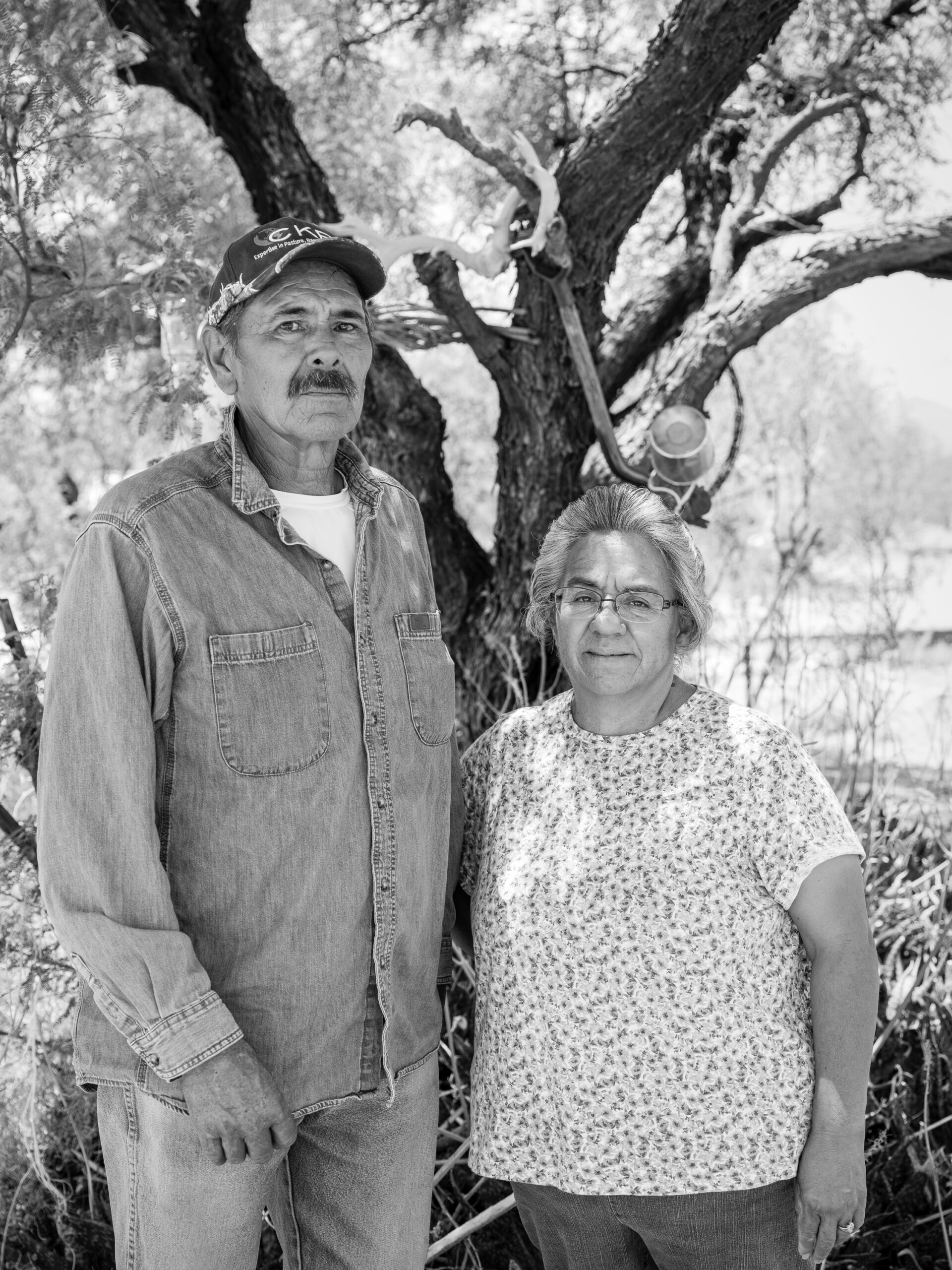
Art Garcia and Gloria Zazueta have been helping find lost migrants on the reservation for nearly 15 years. Image: Roberto (Bear) Guerra/HCN
Zazueta and her daughter were at the dining room table on Oct. 19, decompressing after a long day at work, when her phone pinged: A woman and two companions were lost in the desert, an aid worker told her. It was Claudia, the missing boys’ aunt, and her friends. They had driven as close as they could to the boys’ Google map location and then set out to search on foot. For nine hours, they scoured the desert. When they passed the remains of a horse, Claudia realized they were out of their depth. By nightfall, they called 911.
When Zazueta, who had already set out with flashlights and water, learned that the little group was in tribal police custody, she called and offered to host them so they could stay on the reservation without official permission. “This is what we do,” she told the baffled officers. “That’s someone’s family out there, and we can help.”
Zazueta gets emotional when she remembers the first case she took on: a young woman from Guatemala named Doraine. Her family encountered Doraine’s elder relatives while they were putting up missing person fliers in Sells, on the reservation. After hearing about Doraine’s young children, they agreed to help. From July 6 until the end of the year, Zazueta’s family — including her now 83-year-old mother — accompanied their guests on all-day search expeditions. Some weekends, Doraine’s relatives would return to California, crowdsource more gas money, and return. The search yielded the remains of five people, but Doraine was not among them. “That was hard, because we couldn’t help give them that closure,” Zazueta said. After that year, word spread. Aid groups and migrant families abroad contacted her directly, sending coordinates, photos, prayers and screenshots.
Zazueta and her husband, Arthur Garcia, are skeptical of border agents’ commitment to finding lost migrants. “It’s that mentality of ‘I’ll just let the next shift pick it up,’” she said. She’d seen tire tracks leading away from bodies, she said. “It’s just more paperwork for them to have to sit and do.”
Garcia recently served as a tribal monitor for the surveillance towers CBP erected on the reservation — around 10 of them in a 75-mile radius. He and his wife don’t see why agents can’t stop and process the migrants earlier — at the border wall — given all their expensive surveillance technology, instead of letting them get so deep in the desert and chasing them onto Tohono land.
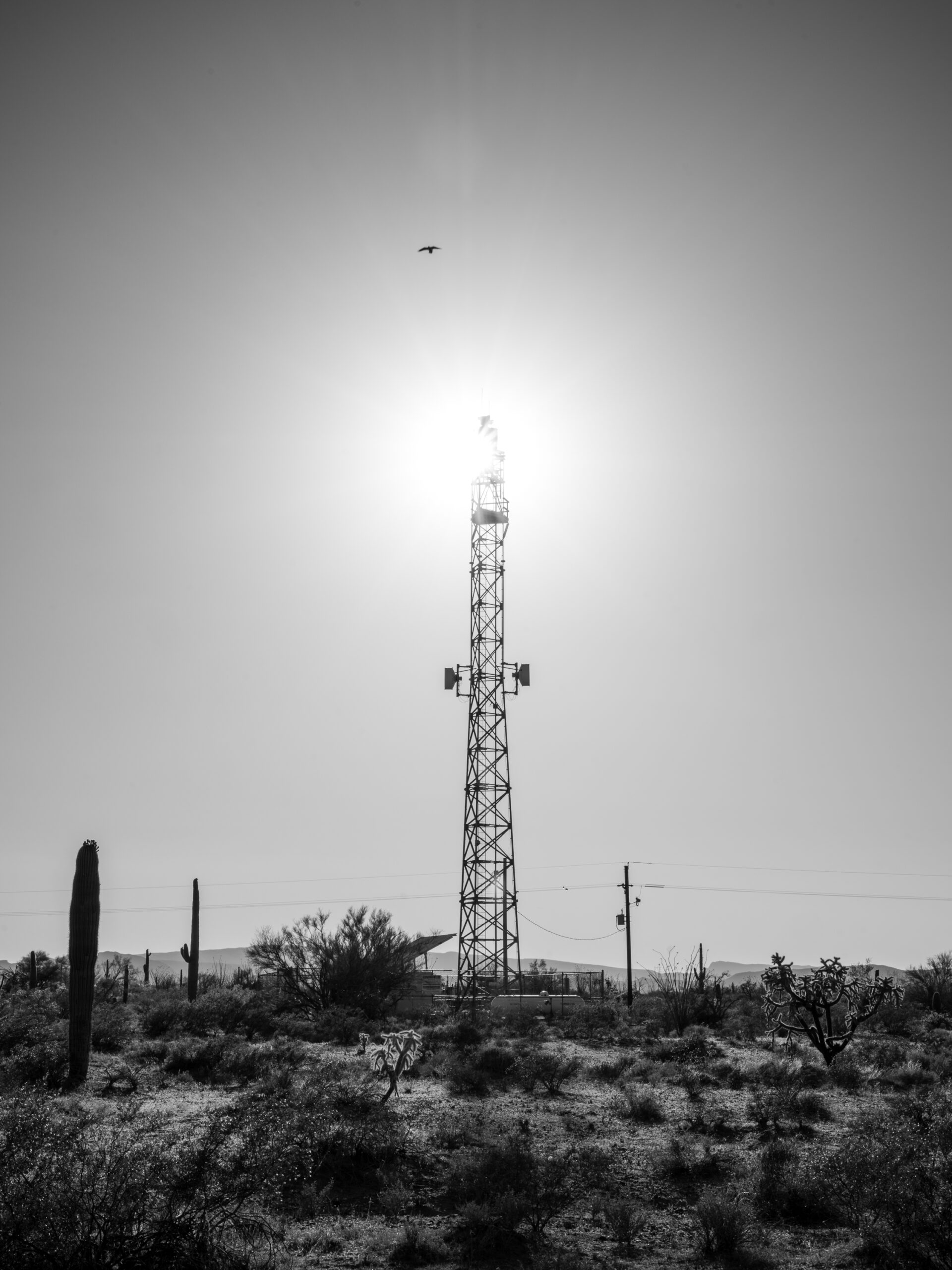
A Customs and Border Patrol surveillance tower in Arizona. According to the Electronic Frontier Foundation, as of July 15, 2024, there were 479 surveillance towers along the entire U.S.-Mexico border. Image: Roberto (Bear) Guerra/HCN
The Border Patrol’s presence has often caused tension on the reservation. Garcia said agents plow through pastures on their vehicles, injure cattle, cut through fences and disrupt hunting. Recently, after agents shot a tribal member on the steps of his own home, the Justice Department declined to press charges against the officers involved. (The family of the slain man filed a lawsuit in 2024.) Several of Zazueta’s relatives have had at least one run-in with agents who entered their garden and scared the kids or confiscated a car to check the fuel tank. Garcia, who is his tribal district’s cattle roundup leader, has several similar stories. Once, he said, he was charged for getting into a verbal altercation with an agent, though the case was dismissed after he completed a pretrial diversion program. Another time, he was handcuffed and pepper-sprayed in front of his then-young daughter and her entire school bus. The family filed a formal complaint with CBP from tribal police. They even pursued a legal claim, but the case fell apart.
Relationships were particularly strained under the Trump administration, when members of the humanitarian group No More Deaths were prosecuted on charges related to their humanitarian work. The most high-profile case involved Scott Warren, a volunteer who was arrested shortly after No More Deaths released videos showing border agents knocking over water containers aid workers had set out. Warren was charged with harboring undocumented immigrants and tried twice but ultimately acquitted.
In 2019, following several reports criticizing earlier incidents involving the Border Patrol’s rescue program, No More Deaths filed a public records request seeking documents on the agency’s emergency response policies and practices. The hundreds of documents shared with HCN and Type include incident reports and internal communications about rescues from across the Borderlands, detailing how migrants got into trouble or went missing after fleeing border agents. In 2017, for example, agents in Arizona “jumped two groups’’ and apprehended two people. One of them escaped and fled up a mountain. “It was determined that the risk of sending agents up the mountain at night outweighed the reward of potentially re-apprehending the suspected IA (illegal alien),” the report noted. In another incident, from 2019, a BORSTAR unit was called in to help retrieve a migrant who “had absconded” and then “become unconscious/unresponsive” on a mountaintop in southern Arizona.
The night of Oct. 19, Gloria Zazueta put Claudia and her group up at her mother’s house, around six miles from the border on the San Miguel Road. This lonely thoroughfare connects Sells, an unincorporated town that is the capital of the Tohono Nation, to a special gate on the U.S.-Mexico border where tribal members can cross to see relatives and visit sacred sites. (The 1853 Gadsden Purchase split the Tohono O’odham territory between the U.S. and Mexico. Zazueta’s mother, who now lives in Sells, was born on the other side of the border in Mexico.)
The group showered and tried to rest. In the morning, they pored over a large laminated map of the Tohono O’odham Reservation, comparing the terrain in the location screenshot the boys sent with the topography on the map. When Zazueta’s brother Juan arrived to pick them up, they pointed to the hills they thought might be a match.
Juan had assisted his sister in helping lost migrants since 2015 with his “quad” — an all-terrain four-wheeler. His life experience came in handy: When he was younger, he worked as a mule, smuggling marijuana between the U.S. and Mexico, crimes for which he served almost 10 years in prison. Unlike many of the border agents recruited from elsewhere, he knew the land intimately; it was his backyard. (In 2023, he began serving a new sentence for a 2020 charge of transporting a migrant.)
He took the group down a dirt road that led to a peak he thought he recognized on the map. They were almost there when Claudia glimpsed some movement. “Stop, stop, stop,” she told Juan. J.G., pale but alive, stumbled out from under a mesquite. The location seemed to match the screenshot the boys had originally sent out.
Juan Zazueta called the tribal police, who notified the Border Patrol, which was waiting for them back in a nearby village. J.G. was disoriented and dizzy, so the agents checked him out and rehydrated him before they took him away. When his cousin, who had left J.G. to seek help, returned to that very spot later that day, he saw the fresh tire tracks and started following them. When he finally saw a Border Patrol vehicle, he threw himself at it.

Gloria points to the location where she found the two Guatemalan boys who became lost while crossing through the expansive Tohono O’odham Reservation. Unlike CBP officers who have advanced technology at their disposal, she typically uses only a large laminated map of the area and her cell phone to locate migrants. Image: Roberto (Bear) Guerra/HCN
His cousin was processed and deported to Mexico within hours, while J.G. himself was transported to St. Mary’s Hospital in Tucson.
The field agents who picked up J.G. did not tell his aunt and uncle where they were taking him, so the family turned again to the Guatemalan Consulate and to Agundez. On Oct. 21, Agundez texted them, telling them where J.G. was being treated. Carlos later thanked the agent for allowing his wife to drop off some money and a change of clothes for her nephew. “Finally, we got one thing right,” Agundez texted back.
At the hospital, J.G. was diagnosed with metabolic acidosis likely caused by severe dehydration. After he was discharged on Oct. 22, he was wheeled out by a friendly agent, who asked J.G. what he wanted to study. Criminology, J.G. said. Once they got to the processing center, the officer handed J.G. off to a colleague. There was nothing more he could do, the officer said. It was at that moment J.G. realized he would not be able to stay in the U.S.
The agent who took over J.G.’s case presented a grim choice: J.G. could leave for Mexico immediately, or he could spend a month in an ICE facility, waiting for a flight to Guatemala. J.G. chose the first option.
It was the inevitable outcome of calling 911 — the option he and his cousin had desperately hoped to avoid. That call “was really our last resort to survive,” he said. “But they didn’t help us. It was my aunt and uncle who moved heaven and earth to find us.”
J.G. boarded a bus with other migrants who were being dropped off in Mexico that day. His shirt and shoes had been taken away for the duration of the ride across the border. He felt like he was being taken to prison.